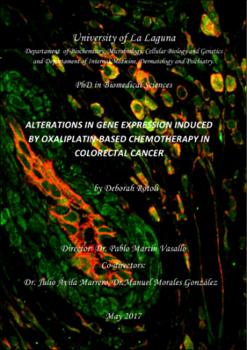Alterations in gene expression induced by oxaliplatin based chemotherapy in colorectal cancer
Autor
Rotoli, DeborahFecha
2017Resumen
We analized the expression of the scaffold proteins IQGAP1, FKBP51 and AmotL2 and the Na,K-ATPase a and ß subunits in colorectal cancer and liver metastases after the administration of oxaliplatin-based chemotherapy. Double immuno-fluorescence protein localization, along with specific cell markers, on human cancer tissue specimens, showed that the expression levels and the subcellular redistribution of IQGAP1, FKBP51 and AmotL2 proteins in CRC cells and related metastases, are indicative of their involvement in CRC tumorigenesis, progression and EMT process. The co-localization of the three proteins with CD34 and/or CD31 in several cell vessels suggests their involvement in tumour angiogenesis and/or in vascular invasion. Due to the key role that these scaffold proteins exert in the dynamics of tumor cells, they represent an attractive group of interacting proteins that could be used as biomarkers for diagnostic staging and as targets for therapy. The expression pattern and localization of the a and ß subunits of the Na,K-ATPase is also affected in CRC, in metastases and in metastasized liver tissue. The a1, a3 and ß1 isoforms are the most highly expressed in tumour cells and metastases. The high levels of perinuclear and cytoplasmic a3 isoform detected in malignant liver tissues, suggests moonlighting functions for this isoform, besides ion transport. The possible predominant isozymes present in tumour and metastatic cells are a1ß1 and a3ß1, which exhibit the highest and lowest sodium ion affinity respectively, and the highest potassium ion affinity. These isozymes are likely to favor optimal conditions for the function of nuclear enzymes involved in mitosis, suggesting a possible role for this isozyme as a novel biomarker for CRC metastatic cells in liver. Analizamos la expresión de las proteínas IQGAP1, FKBP51 y AmotL2 y las subunidades a y ß de la Na, K-ATPasa en cáncer colorrectal y metástasis hepáticas después de la administración de quimioterapia basada en oxaliplatino. La doble localización por inmunofluorescencia de las proteínas, junto con marcadores celulares específicos, en muestras de tejido de cáncer humano, mostró que los niveles de expresión y la redistribución subcelular d las proteínas IQGAP1, FKBP51 y AmotL2 en células de CRC y metástasis relacionadas, son indicativos de su implicación en la tumorigénesis y progresión de CRC y en el proceso de EMT. La co-localización de las tres proteínas con CD34 y/o CD31 en varios vasos celulares sugiere su implicación en la angiogénesis tumoral y/o en la invasión vascular. Debido al papel clave que estas proteínas de andamio ejercen en la dinámica de las células tumorales, representan un grupo atractivo de proteínas interactuantes que podrían usarse como biomarcadores para la estadificación diagnóstica y como objetivos para la terapia. El patrón de expresión y la localización de las subunidades a y ß de la Na, K-ATPasa también se ve afectada en CRC, en metástasis y en tejido hepático metastatizado. Las isoformas a1, a3 y ß1 son las más expresadas en células tumorales y metástasis. Los altos niveles de isoforma a3 perinuclear y citoplásmica detectados en tejidos hepáticos malignos, sugieren funciones moonlighting para esta isoforma, además del transporte iónico. Las posibles isoenzimas predominantes presentes en las células tumorales y metastásicas son a1ß1 y a3ß1, que exhiben la afinidad de iones de sodio más alta y más baja, respectivamente, y la mayor afinidad de iones de potasio. Es probable que estas isoenzimas favorezcan las condiciones óptimas para la función de las enzimas nucleares involucradas en la mitosis, sugierendo un posible papel como biomarcador para células metastásicas de CRC





